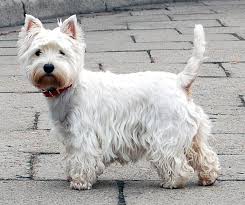West Highland White Terrier dogs, often referred to as Westies, are captivating and charismatic dogs that have earned a special place in the hearts of dog lovers worldwide. With their distinct white coats and endearing personalities, Westies possess a charm that is truly unique.
This breed’s origin can be traced back to the rugged landscapes of Scotland, where they were bred to be tenacious hunters and loyal companions. Today, the West Highland White Terrier is cherished not only for its hunting abilities but also for its unwavering devotion and playful nature.
One cannot help but be captivated by the Westie’s striking appearance. Their pristine white double coat is a standout feature, reflecting their regal and refined disposition. The coat is weather-resistant, allowing these spirited terriers to enjoy outdoor adventures without worry.
Their almond-shaped, dark eyes exude intelligence and curiosity, while their erect ears add a touch of alertness and expressiveness. Standing at a compact yet sturdy size, Westies possess an elegant gait that showcases their innate confidence and poise.
Beneath their charming exterior lies a personality that is both endearing and entertaining. West Highland White Terriers are known for their spirited nature and feisty character. Despite their small stature, they possess an indomitable spirit, which can be traced back to their history as working dogs. Westies are not afraid to take on challenges and will fearlessly protect their loved ones.
Their boundless energy and enthusiasm make them excellent playmates for both adults and children, as they thrive in active households that can provide them with ample mental and physical stimulation.
Beyond their playful nature, Westies are renowned for their unwavering loyalty and affection towards their families. They form deep bonds with their human companions, often displaying a strong desire to be involved in every aspect of their lives.
Whether it’s going for a leisurely walk, snuggling on the couch, or engaging in a lively game, the Westie’s unwavering devotion and companionship make them a cherished presence in any home. Their sociable nature also extends to other pets, as they generally get along well with fellow canines and even cats when properly introduced.
While Westies have a strong instinct to explore and investigate their surroundings, they are intelligent and highly trainable. With consistent positive reinforcement and gentle guidance, these clever canines quickly grasp commands and excel in obedience training.
However, it’s important to remember that their independent nature can occasionally result in a touch of stubbornness. Patience, understanding, and a firm yet gentle approach are key to nurturing their best qualities and ensuring a harmonious bond with their owners.
Another advantage of the West Highland White Terrier breed is its overall good health. Though every dog is unique and may have specific health considerations, Westies generally enjoy a long lifespan of 12 to 16 years. Regular exercise, a nutritious diet, and routine veterinary care are essential for maintaining their well-being and ensuring they lead a fulfilling life.
The West Highland White Terrier is a remarkable breed that has earned its place as a cherished companion. With their striking appearance, spirited personality, and unwavering loyalty, Westies have an undeniable allure that captures the hearts of dog enthusiasts around the globe. Whether by your side during an outdoor adventure or snuggled up at home, the Westie’s presence is sure to bring joy, laughter, and an abundance of love to any household fortunate enough to call one their own.
Read Also: Komondor Dogs: Description and Complete Care Guide
History and Origin of the West Highland White Terrier Dogs

The history and origin of the West Highland White Terrier, affectionately known as the Westie, can be traced back to the rugged landscapes of Scotland. This beloved breed emerged in the 19th century, bred to possess specific qualities that would make them exceptional hunters and trusted companions.
The West Highland White Terrier shares its ancestry with several other Scottish terrier breeds, including the Cairn Terrier and the Scottish Terrier. These terriers were developed to hunt small game such as foxes, rats, and other vermin that threatened the farms and estates of Scotland.
In the past, terriers with varying coat colors were used in hunting. However, the white-coated terriers had a disadvantage because they were often mistaken for prey or game in the field. To address this issue, Colonel Edward Donald Malcolm of Poltalloch, a Scottish landowner, decided to selectively breed white terriers that were highly visible in the field, hence avoiding any confusion during the hunt.
Colonel Malcolm is often credited as the pioneer of the West Highland White Terrier breed. He specifically bred white terriers from his Cairn Terrier lineage, which were known for their resilience and hunting abilities. Over time, he refined the breed, emphasizing their distinctive white coat and their tenacity as hunters.
The dogs were initially called “Pol-tal-och Terriers” after Malcolm’s estate, but eventually, they came to be known as West Highland White Terriers, named after the region they originated from.
The West Highland White Terrier’s hunting prowess and adaptability soon gained recognition outside Scotland. The breed’s popularity soared in the early 20th century, thanks to their charming appearance and delightful personalities. They were first officially recognized by the Kennel Club in the United Kingdom in 1907 and by the American Kennel Club in 1908.
Since then, the West Highland White Terrier has firmly established itself as a beloved companion dog worldwide. While they may no longer be primarily bred for hunting, their hunting instincts are still evident in their spirited demeanor and keen alertness. Today, Westies are treasured for their loyalty, playfulness, and unwavering devotion to their families.
The breed’s journey from working terrier to beloved family pet highlights their remarkable adaptability and enduring appeal. Their rich history and the efforts of breeders and enthusiasts have helped shape the West Highland White Terrier into the lovable and distinctive breed we know today.
Health Issues and Lifespan of West Highland White Terrier Dogs

The West Highland White Terrier, like any other breed, may be prone to certain health issues. However, overall, they are considered a relatively healthy breed with a good lifespan. Responsible breeding practices and regular veterinary care can help ensure the well-being and longevity of these beloved companions.
One common health concern in Westies is skin allergies. They may develop allergies to certain foods, environmental factors, or even specific grooming products. Symptoms can range from itching and hair loss to skin infections. Identifying and managing the underlying cause of the allergies, such as through dietary adjustments or environmental changes, can help alleviate these issues.
Another condition that may affect Westies is patellar luxation, a condition where the kneecap slips out of its normal position. This can cause lameness or discomfort. In more severe cases, surgical intervention may be necessary to correct the issue and improve the dog’s quality of life.
West Highland White Terriers are also susceptible to a liver disease called copper toxicosis. This genetic condition leads to an abnormal accumulation of copper in the liver, which can cause liver damage or failure. Regular monitoring of liver function and appropriate dietary management are essential to mitigate the effects of this condition.
Additionally, like many small dog breeds, Westies may be prone to dental problems such as periodontal disease. Regular dental care, including brushing their teeth and providing appropriate chew toys, can help maintain good oral hygiene and prevent dental issues.
The average lifespan of a West Highland White Terrier is typically around 12 to 16 years. However, it’s important to note that individual dogs may vary, and factors such as genetics, diet, exercise, and overall healthcare play a significant role in determining their lifespan.
By providing a balanced diet, regular exercise, routine veterinary check-ups, and appropriate preventive care, owners can help ensure their Westies live a long and healthy life.
It is crucial for prospective owners to source their Westies from reputable breeders who prioritize health testing and genetic screenings. Responsible breeders strive to reduce the risk of hereditary health conditions by selecting breeding pairs with good overall health and genetic backgrounds.
However, while the West Highland White Terrier is generally considered a healthy breed, they may be prone to certain health issues such as skin allergies, patellar luxation, copper toxicosis, and dental problems. With proper care, regular veterinary check-ups, and attention to their specific needs, owners can help mitigate these concerns and ensure their Westies enjoy a happy, active, and fulfilling life.
Read Also: Belington Terrier Dogs: Description and Complete Care Guide
West Highland White Terrier Dog Breed Complete Grooming and Care Guide

The West Highland White Terrier, also known as the Westie, is a breed that requires regular grooming and care to maintain their distinctive white coat and overall health. By following a comprehensive grooming routine and providing attentive care, you can keep your Westie looking and feeling their best. Here’s a complete guide to grooming and caring for your West Highland White Terrier:
Coat Care:
Brushing: Westies have a double coat consisting of a soft undercoat and a harsh outer coat. Regular brushing, at least two to three times a week, helps remove loose hair and prevent matting. Use a slicker brush or a pin brush to gently remove tangles and keep the coat in good condition.
Bathing: Westies typically need bathing every four to six weeks or as needed. Use a high-quality dog shampoo specifically formulated for white coats. Be sure to thoroughly rinse the coat to prevent any residue.
Coat Trimming: Professional grooming or hand-stripping is recommended for Westies to maintain their characteristic appearance. Hand-stripping involves plucking out dead hairs by hand, which helps preserve the texture and color of the coat.
Ear Cleaning: Check the ears regularly for dirt, wax buildup, or signs of infection. Use a veterinarian-recommended ear cleaner and gently wipe the outer ear with a cotton ball or a soft cloth. Avoid inserting anything into the ear canal.
Dental Care:
Brushing Teeth: Dental hygiene is important for Westies to prevent dental problems. Brush your dog’s teeth regularly using a dog-friendly toothbrush and toothpaste. Start slowly and gradually introduce the toothbrush to your dog’s routine.
Nail Care:
Regular Trimming: Trim your Westie’s nails every two to three weeks, or as needed, to prevent overgrowth. Use a quality nail clipper or grinder designed for dogs, taking care not to cut into the quick, which can cause bleeding and discomfort.
Eye Care:
Check for Discharge: Inspect your Westie’s eyes regularly for any signs of redness, discharge, or irritation. If you notice any abnormalities, consult your veterinarian for guidance.
Exercise and Mental Stimulation:
Daily Exercise: Westies are active and energetic dogs that require regular exercise to keep them physically fit and mentally stimulated. Engage in daily walks, play sessions, or interactive games to provide them with the necessary outlet for their energy.
Nutrition and Health:
Balanced Diet: Feed your Westie a high-quality dog food that meets their nutritional needs. Consult your veterinarian for specific dietary recommendations based on your dog’s age, size, and activity level.
Regular Vet Check-ups: Schedule routine veterinary check-ups to monitor your Westie’s overall health, vaccinations, and preventive care, including flea and tick prevention.
Love and Attention:
Westies thrive on human companionship and attention. Spend quality time with your Westie, providing them with affection, socialization, and mental stimulation. They are a loyal and loving breed that thrives on the bond they share with their owners.
By following this complete grooming and care guide, you can ensure that your West Highland White Terrier remains healthy, happy, and looking their best. Regular grooming, proper dental care, exercise, a balanced diet, and regular veterinary care will contribute to your Westie’s well-being and strengthen the bond between you and your furry companion.
Read Also: Essential Baby Gear: Must-Have Products for New Parents
